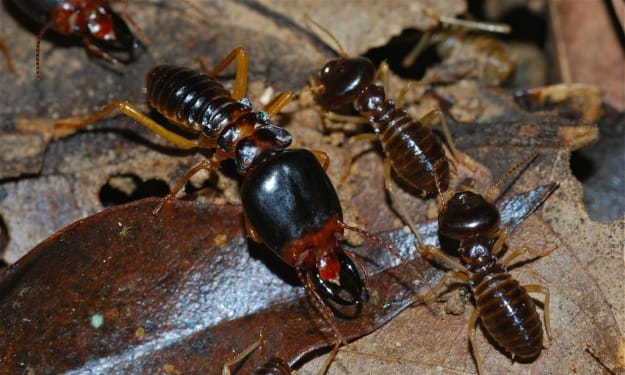
Cuttlefish may be the most amazing types of life on The planet, or possibly close to the highest point of most records.
Picture a submerged animal that flaunts three hearts, siphons nobility, and has skin that can flash, change, and gleam like the fantastic display of Times Square.
The lively and baffling Sepia bandensis, or as it is normally known, the bantam cuttlefish, is the focal point of a momentous report.
Making a mind map book of the cuttlefish
Over a range of three years, a mixed group of neuroscientists, information specialists, and website specialists from Columbia's Zuckerman lab have been taken part in a venture to grasp the multifaceted functions of this captivating cephalopod's cerebrum.
UN Boss: Non-renewable energy source industry period should end for humankind's endurance
Nature's quiet language: Interpreting the manner in which bugs utilize compound signs to impart
What makes the Gentoo penguin the world's quickest swimming bird?
Robots can now figure out how to achieve any undertaking by watching recordings or noticing individuals
New types of ankylosaur found on the Isle of Wight
Understand more...
Their endeavors have brought about the making of a cerebrum map book for the bantam cuttlefish. This guide outlines, interestingly, the 32 curves of its cerebrum alongside its one of a kind cell structure.
Being an expert of mask, the bantam cuttlefish can change its skin example and surface quickly to mix in with its environmental factors.
This disguise is coordinated by what the cuttlefish sees and its cerebrum answers by controlling a huge number of cell pixels in its skin. This phenomenal capacity permits the cuttlefish to reflect its visual climate on its own skin.
Richard Axel's lab is set on a mission to figure out how this uncommon interaction functions. As per Axel, understanding how visual data is handled in the cerebrum, whether in cephalopods or people, is quite possibly of the most convincing test in neuroscience.
To concentrate on the brain systems of cuttlefish cover, the Axel lab needed to record neuronal action from the cuttlefish's mind. Yet, to remove the main data, a mind map was required, and as of recently, such a guide wasn't accessible.
Building the Cuttlebase
As a feature of their examination, they dealt with building a neuroanatomical chart book of the bantam cuttlefish cerebrum. Their discoveries have been distributed web-based in Current Science, and they have sent off a comparing site, Cuttlebase.org.
Tessa G. Montague, the main creator of the paper and a postdoctoral individual in Axel's lab, expressed, "One of my #1 methodologies for finding out about the mind is to concentrate on animals that are profoundly well versed specifically ways of behaving or errands… "
Montague proceeded to communicate trust that the cerebrum map book will assist mainstream researchers with understanding the systems cuttlefish use to articulate their thoughts through their skin, prompting more extensive bits of knowledge into the operations of any mind.
Creating Cuttlebase required a different gathering of specialists work in neuroscience, tissue imaging, PC programming, life structures, and website architecture.
X-ray sweeps of cuttlefish minds established the groundwork
The underpinning of the mind map book was laid utilizing X-ray outputs of eight cuttlefish. A profound learning calculation was utilized to separate the mind related information from the encompassing tissue in the sweep.
As per Sabrina Gjerswold-Selleck, a co-creator of the paper, the group had the option to adjust a method from past work on mice cerebrum filters. She said, "We were astounded the way that well we had the option to adjust the method."
The errand of characterizing the limits of every cuttlefish mind curve was finished by contrasting X-ray filters with a couple of named cerebrum pictures from the 1960s. This enormous exertion brought about many grayscale pictures portraying the layouts of the mind districts.
The specialists then utilized histological methods to redesign their mind map book, offering cell goal. This elaborate staining segments of cuttlefish minds to stamp the areas of neurons, glial cells, and axons.
In the end, the eight cuttlefish mind pictures were converged into a solitary chart book. They recognized 32 curves altogether. Every curve has explicit organic capabilities and ways of behaving.
"The primary motivation behind the paper is to report the perception and examination instrument, Cuttlebase, and to make it all openly accessible and effectively available to everybody," Montague said.
Cuttlebase is a unimaginable asset for all
The easy to understand highlights of Cuttlebase permit everybody to get to and find out about the cuttlefish mind and its unpredictable operations. Cuttlebase has all that from itemized histological segments of various cerebrum locales to a zoomable 3D model of the mind and, surprisingly, a full model of the cuttlefish's 26 organs.
The site gives a vivid and instructive experience. This is all finished with an end goal to assist researchers with wherever promoting how they might interpret the cuttlefish cerebrum.
Sukanya Aneja and Dana Elkis, some portion of the Cuttlebase group and co-creators of the paper, assumed driving parts in making the site. Aneja shared the difficulties they looked in making the mind boggling information easy to use and interesting to the two researchers and non-researchers.
Elkis added that the site expected to coordinate recordings, pictures, 3D models, outlines, graphs, and charts to offer an extensive comprehension of their examination.
Isabelle Rieth, a previous Cuttlebase colleague, contributed her plan abilities to guarantee the site was instructive as well as outwardly engaging. The outcome is a site loaded up with energetic varieties, supporting clients in understanding how the situation is playing out.
The examination group stays in wonderment of the astounding cuttlefish
Regardless of the broad work and difficulties the teammates looked in carrying this task to completion, their interest for the bantam cuttlefish stayed undiminished.
Montague shared her awe at watching the cuttlefish, expressing, "While they're disguising or speaking with one another, they're really uncovering to you on their skin what they see and how they feel."
The consequences of this aggressive undertaking have opened entryways for a more prominent comprehension of the bantam cuttlefish and possibly shed light on the more extensive operations of the mind.
Through their endeavors, the Axel lab, and every one of those included, have given a significant asset to the proceeded with investigation and investigation of this exceptional cephalopod.
More about cuttlefish
Cuttlefish, or the Sepiida request, are marine animals that fall inside the bigger classification of cephalopods, which likewise incorporates squids, octopuses, and nautiluses.
They are prestigious for their insight and their extraordinary actual characteristics, for example, their W-molded understudies, variety evolving skin, and an inner shell called the cuttlebone.
Here are a few critical parts of cuttlefish:
Science
Cuttlefish have delicate bodies and a novel interior shell, the cuttlebone, which helps control lightness by changing the gas-to-fluid proportion inside the permeable bone. Their bodies are many times expansive and smoothed with a blade that borders the body and helps in swimming. They have eight arms and two longer appendages that are normally concealed, which they use for getting prey.
Vision
Cuttlefish have profoundly evolved eyes, which are accepted to be completely evolved before birth. This permits child cuttlefish to notice their environmental elements while still in the egg. Regardless of being partially blind, cuttlefish have perhaps of the most refined visual framework in the collective of animals. They can see enraptured light and have a wide field of vision.
Variety Change and Cover
Cuttlefish are renowned for their capacity to quickly change their skin tone and example. They can involve this capacity for correspondence or, all the more normally, for cover to safeguard themselves from hunters.
This is a consequence of particular cells — chromatophores, iridophores, and leucophores — that are situated in the upper layer of the skin and can be controlled to make mind boggling and dynamic examples.
Diet and Hunting
Cuttlefish are savage. Their eating routine essentially comprises of little molluscs, crabs, shrimp, fish, octopus, worms, and other cuttlefish. They chase by covertness, surprising or drawing in their prey prior to holding onto it with their appendages.
Multiplication
Cuttlefish recreate physically, with guys as a rule seeking females with stunning variety shows. In the wake of mating, the female lays her eggs on the ocean bottom, frequently concealing them inside hole or under edges. Cuttlefish have a somewhat short life cycle, living from one to two years by and large.
Knowledge
Cuttlefish are thought of as exceptionally canny among spineless creatures, showing a serious level of learning, variation, and memory use. They've been known to tackle labyrinths, mirror different creatures, and even use instruments.
Dangers
Regular hunters of cuttlefish incorporate dolphins, sharks, fish, seals, seabirds, and other cuttlefish. People likewise fish cuttlefish for food and, in certain spots, they are viewed as a delicacy. Cuttlebones are in many cases utilized as a calcium supplement for pet birds. Contamination and environment annihilation likewise undermine cuttlefish populaces.
While this data gives an outline of cuttlefish collectively, it's significant that there is incredible variety inside this arrangement. Various types of cuttlefish might differ fundamentally in size, life expectancy, conduct, and different qualities.






Comments
There are no comments for this story
Be the first to respond and start the conversation.